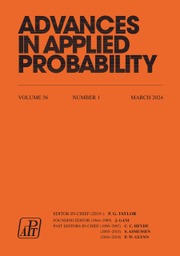No CrossRef data available.
Article contents
Estimation of on- and off-time distributions in a dynamic Erdős–Rényi random graph
Published online by Cambridge University Press: 09 October 2025
Abstract
In this paper we consider a dynamic Erdős–Rényi graph in which edges, according to an alternating renewal process, change from present to absent and vice versa. The objective is to estimate the on- and off-time distributions while only observing the aggregate number of edges. This inverse problem is dealt with, in a parametric context, by setting up an estimator based on the method of moments. We provide conditions under which the estimator is asymptotically normal, and we point out how the corresponding covariance matrix can be identified. We also demonstrate how to adapt the estimation procedure if alternative subgraph counts are observed, such as the number of wedges or triangles.
Keywords
MSC classification
Information
- Type
- Original Article
- Information
- Copyright
- © The Author(s), 2025. Published by Cambridge University Press on behalf of Applied Probability Trust


